|
FAQs about Morays Eel Identification
5
Related FAQs: Moray IDs 1, Moray IDs 2, Moray
IDs 3, Moray IDs 4,
Moray IDs 6,
Moray IDs 7, Moray IDs 8,
Moray IDs 9, &
Moray Eels 1, Moray Eels 2, Moral
Eels 3, Moray Selection,
Moray Behavior, Moray Compatibility, Moray Systems, Moray Feeding, Moray Disease, Moray Reproduction, Zebra Moray Eels, Snowflake Morays, Freshwater Moray Eels,
Other Marine Eels,Related Articles: Moray
Eels, Zebra Morays, Snowflake Morays, Ribbon Morays, The "Freshwater" Moray
Eels, Freshwater Moray
Eels by Marco Lichtenberger,
Other Marine
Eels,
|
.JPG)
|
|
Moray ID's for Marco 2/23/11
Hi Marco,
<Hello Pat.>
Two new additions for you to take a peek at. The first might be
zonipectis; he could fit inside a hollow pencil so it's
difficult to tell, and photograph.
<No. G. zonipectis has a much different and very specific set
of dark and bright spots at the side of the head even when very
small and it has a different head shape. I've seen your
species imported, photographed as G. richardsonii, too, but this
is wrong as well, even if the chances are not bad to get this
species instead of G. richardsonii in an import. Upon a closer
look at your picture I am almost a 100% sure this is G.
chilospilos given overall coloration, lip spots, white spot at
the jaw, lack of dark spots and head shape. See here
http://calphotos.berkeley.edu/cgi/img_query?enlarge=4444+4444+1106+0760
and
http://www.fishbol.org/species.php?region=1&id=9712
>
The second is supposed to be neglectus... regardless he's
awesome, but after some research I have some doubts as to the ID.
Check out the pictures I took, as well as the ones I borrowed
(the last two) - note the 'horns' above the eyes on my
specimen (something like a dragon. by the way, is there a name
for the nostrils on top of the head, as opposed to on the
nose?).
<Rear nostrils, posterior nostrils. Can have short tubes on
Gymnothorax spp. as seen here.>
They don't seem to appear in the borrowed picture,
<Oh they do at least on the one with the bent jaw and the
other one is much too small to see them. Have a closer look above
the right eye of the eel in the bent jaw picture you'll see
the dark tube.>
or any others attributed to neglectus I've seen. The shape of
the skull just seems to be different all together.
<I tend to say they look alike... your specimen being a
younger version.>
He comes from the leftern Pacific, <Country?> if that
helps.
<Honestly, your pictures are too blurry to see much detail,
especially the rear nostrils, overall coloration of the eel, its
gill opening would be interesting. Despite the blurriness, do I
see a slightly white margin at the fin? This is a character of G.
neglectus. The gill opening of G. neglectus is dark, is this the
case here? From what is visible it does look like the G.
neglectus in Chen et al.'s Review of Taiwan's morays.
Take this one as reference for body coloration from front to
back:
http://www.fishbase.org/Photos/PicturesSummary.php?StartRow=0&ID=10145&what=species&TotRec=2
>
Second to last question - in the second to last picture the
eel's jaws seem to be bent/crossed. I've seen this before
in pictures and once at a public aquarium. Any idea what causes
this?
<Yes: two morays fighting for the same piece of food with one
biting the jaw of the other and dislocating it. Not uncommon in
tanks with several strong morays and not so careful keepers. Can
occur in nature, too and apparently does not seem to disable the
eels.>
Ever seen Enchelycore schismatorhynchus? That's next on my
list.
<Yes, but caught by a fisherman and dead. Good luck!>
Best regards, Patrick Corcoran
<Marco.>
PS- The four pics names 'Gymno_Ssp...' are mine, do with
them what you want. The other two aren't, so please don't
republish them.
<Thanks for sending your pictures. Nice eels! Let's link
to the borrowed picture with the bent jaw for the other
readers:
http://www.flickr.com/photos/thailandbeach/3756922758/
Pat seems to know very well what he is doing. For some others,
please remember G. neglectus mostly occurs in sub-tropical to
temperate waters, G. chilospilushas a wider distribution in
tropical and subtropical waters.>
|
|
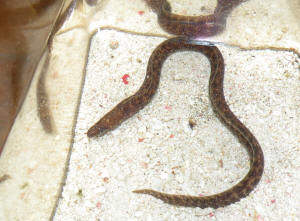 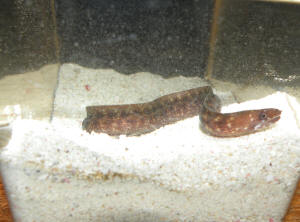
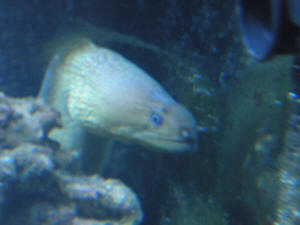 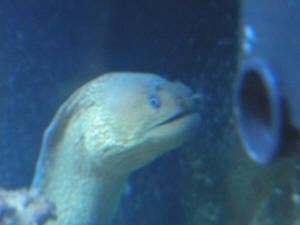
|
|
Re: Moray ID's for Marco 2/24/11
Good call man! ID looks spot on to me as well. The search for
zonipectus continues....
<Should be a possible task for a collector. They are not that
rare.
However, many collectors won't be able to ID it.>
Good call as well on neglectus... he does in fact have a defined
white margin along his fin. He apparently came from Japan, if
that helps you at all.
<Yes, it does (less possibilities for wrong ID). After a
second look at your pictures, your eel probably looks more like
G. neglectus than the borrowed pictures.>
Can you tell me where the E. schismatorhynchus you mentioned came
from?
<Taiwan, but following other record they should be far more
widespread.>
Re: Broken jaws and moray care - I usually don't spot feed as
a single piece of food on a stick seems to cause more infighting
than dumping chunks of food into the tank. I do, however, use a
stick to ensure everyone gets their fair share and avoid
potential fights. It works well - I haven't had an injury in
8 years (one before that towards the beginning of my mostly moray
only career).
<I use long tweezers. Every eel gets the piece intended for
it.>
I also 'shark tank' new specimens before fully
introducing them to an occupied tank - this also works well.
Lastly, I run chillers on all my tanks - the neglectus is
with the anatina's at 68 degrees, as are my deeper water
species (berndti, ypsilon, etc), my dragon, kidako and koke seems
to enjoy 72 degrees or so.
-Pat
<Sounds good. Cheers, Marco.>
|
|
ID of Moray eel 2/3/11
Hi WWM crew,
Good day to you. Can you help me to identify this eel? My LFS
brought it in from Brazil shipment and the invoice only state
Banana eel, no scientific name. It is yellow with a black dot on
its dorsal. Many thanks and God Bless.
Regards
Kellvin
Singapore
Hello Kellvin,
No problem, this is the yellow (scientifically speaking
xanthistic) color variant of Gymnothorax miliaris. It's often
traded as Banana eel, sometimes even as yellow dwarf moray (which
it is not) or Golden eel. I've imported them myself some
years ago, too. Nice medium sized eel. Sometimes a little picky
with regard to food (one of the two I keep myself), but not
problematic. Keep it just like a regular colored G. miliaris.
Cheers,
Marco.
Help, ID of Moray eel 2/17/11
Hi Marco,
My fish k
<Sorry Kellvin, I am not sure if I understand, the text ends
after the "k".
I guess you mean you bought it. If so: congrats. Marco.>
Kellvin Lim
|
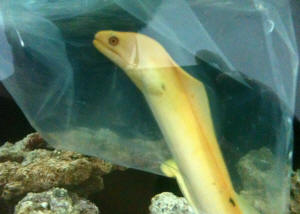 |
|
Moray identification... Pholodichthys
12/27/10
Hi:
<Howsit?>
Have a look and help me please. This guy (gal?) is new and
reportedly from the "western Pacific".
<Mmm, is>
Bar count is lower than for E. polyzona, but none of the online
images for G. rueppellii match even closely.
<Nope>
What you can't see in the photo are well defined very fine
dorsal spines that yield a serrated edge along its entire length.
I've got to start a diet soon and assume from the rounded
snout its a crustacean eater. Any help is appreciated.
JZ
<See here: http://wetwebmedia.com/pholodichthyidae.htm
Bob Fenner>
|
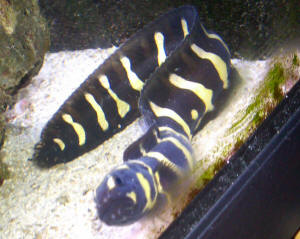 |
Re: Moray identification
12/28/10
Wow
<Heeee~!>
LFS gave this to wife as an 'eel" for a small specimen
tank the day after x-mas.
<Mmm, well, not a true eel, nor goby or blenny for that
matter...>
My 11 year old son said "hey...I think its one of those snake
gobies we had a long time ago" (he meant at least five years
ago!).
<Dang!>
I said that I would look for some juvenile photos of potential
morays. Looks like I have a budding ichthyologist.
<Do get him interested in finance, accounting, marketing... at
least as a double major!>
We'll go back to see if they have a few more of these
"eels" and we'll move them all to the large reef
display.
<Good... is a VERY social species as you've read>
Maybe they can order a juvenile moray for us as this is what he
really wanted.
<Ahh!>
Thanks for the timely help.
JZ
<Certainly welcome. BobF> |
|
Marine Moray Identification Assistance
11/4/10
Hello,
<Hi Jessi.>
1st I would like to commend you on the professionalism of your
site and the assistance you provide!
<Thanks for your kind words.>
I have an extremely juvenile eel (<6") that I was ever so
blessed to have come into my reef tank through live rock.
<Congratulations! A hitchhiker I would gladly welcome.>
I apologize, but I do not know where the rock came from that he
was transferred in on to narrow down a geographical range, as I
have purchased over 100 lbs. of rock from various places.
<Too bad, would certainly be an useful information.>
Approximately 3 months after the purchase of my last piece of
rock, I transferred everything to a bigger tank. In the process,
I left the other tank set up to decipher whether I planned to
have it stay as a marine tank or not. This is when I found him!
After everything settled I put him in a breeder net to take a
picture. As you can see he has some yellowish green on his
tail.
<Yes, I see.>
It has been a few months since this picture and I just saw him
again last night. I will do my best to get a new picture but it
is quite difficult. I can only find him by flashlight at night
when he is "hunting." I assume he is eating amphipods,
I couldn't get him to eat anything for me in the breeder net
which is why I released him back into my reef tank.
<Training a wild caught moray eel to dead food can be a
difficult task depending on the specific eel. You often need a
lot of patience. I highly doubt the eel will be able to survive
in a reef tank on a population of amphipods. There is a variety
of food that can be tried: cephalopod pieces (squid, octopus),
shrimp pieces, fish filet, clam or mussel flesh. I'd place
some food in a clear tube or a bottle where only the eel can get
in and leave it in the tank over night as a start. Sometimes you
have to start with live food: young guppies from a fellow
hobbyist or glass shrimp from the store. I fear you'll either
have to train the eel to dead food or catch it to avoid it
starving with time. Moray eels can starve over long periods of
time. Some morays have refused food over more than 9 months
before they started to eat again!>
His current appearance is the same with the exception that his
body is slightly marbled now. He has not grown much but he has
grown!
Please let me know if there's any other information that
would be helpful.
<One very important thing: Does it have a dorsal fin (back
fin) and where at its back does it start? At the picture it seems
as if it does not. If this is right it's probably a member of
the Uropterygius genus (you would have some rare find there!).
This would be in line with its very secretive behavior. However,
there are also some small brown members of the genus Gymnothorax.
A better side shot would be very helpful with the ID. A
demanding, but also useful picture would show its head with more
detail (especially the front and back nostrils).>
Thanks & God Bless, Jessi
I apologize, I forgot to attach the picture...
<Cheers, Marco.>
|
|
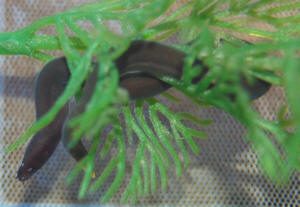
|
|
Re: Marine Moray Identification Assistance
11/5/10
Hi Marco,
<Hello Jessi.>
Thanks for the tip about the food in the bottle. I will have to
try a medicine bottle that my engineer gobies cannot fit in the
mouth of since they eat anything! I can't have small shrimp
because of them. For the eel I have tried Mysis, brine, and krill
while he was in the net and nothing...
<Being in a relatively small net mean stress, which is a good
reason for an eel to not eat. I'd try again with the bottle
in the main tank. I'd also try the food items listed in the
last email.>
I tried dosing the tank with baby squid in the middle of the
night and it wasn't enough to get him out of hiding. I have
not seen a dorsal fin, but will keep looking and hope to
capture you a better image.
<Good luck.>
What do you mean by "back nostrils"?
<Moray eels have 4 nostrils, 2 at the front of the snout
(often with tiny tubes) and two above their eyes on top of the
head. The latter set has typical shapes (e.g. keyhole shape or
round) and colors, which can be a useful character for a genus or
species. There are some marbled members in the genus Uropterygius
with a yellow tip tail. With proper pictures we might me able to
determine the species.>
Thanks again, Jessi
<Cheers, Marco.>
|
|
moray identification - 8/17/10
sorry for the big pictures, netbook is an ssd version and is
slow.
<OK>
I got this moray at the lfs, they said it was sold to them as a
green moray. It does not look like a green moray to me
<Nope, certainly not.>
, can you help id this guy?
<From head shape, lip spots, head coloration and tail tip
coloration I think this is a dark individual of Richardson's
moray Gymnothorax richardsonii (wide range of light colors to
dark colors within this
species). Will stay around one foot and is a good species for
aquarium care (much better than Gymnothorax funebris, the Green
moray). Keep everything covered and beware that small fishes may
be eaten.>
-matt
<Cheers, Marco.>
|
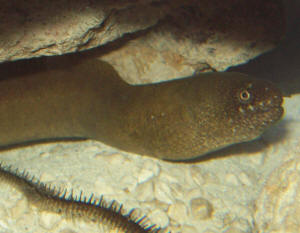 |
|
Re: moray identification
8/18/10
He is currently in a 30gal long with two Damsels(blue and
3-stripe), a Red Claw Crab, a Brittle Star, and Peppermint
Shrimp. Everyone gets along great, although the damsels picked on
him the first day or so they have backed off. If you're
correct about species, he should stay small enough that none of
these will fit in his mouth (he's already about a foot long),
he should also be ok to stay in this tank. Although I will keep
an eye on his appetite and size over the next year to be
sure.
<OK, keep an eye on him. I've seen morays take out bites
of fishes too large to swallow... not a nice thing to watch.
It's good the moray was added last, this certainly reduces
aggression somewhat. Cheers, Marco.>
|
|
My snowflake eel is being attacked by
my more eel.
Unknown eel incompatibility -- 03/24/10
My 2 eels have been living together for months in a 46 gallon bow
flex tank. I bought the more eel
<No such eel. Do you mean moray eel? There are 200 species
from a few inches to 4 metres. It'd have been good to know
what species we are discussing. As a side note, the 46 gallon
tank is too small for a Snowflake eel alone in the long
run.>
after the snowflake and the more eel took over the snowflake eels
cave. So I added another hiding spot, he always stays underground
so I didn't think anything of it. Now the more eel is
attacking the snow flake, he is biting his tail and body and even
his head, he try's to pull him towards him or bring him in
his cave. I'm so scared for the eel, I broke them up several
times, but the more eel keeps going after him. The snow flake is
oblivious and keeps getting attacked. I don't think he is
going to make it much longer, help me please, what can I do. I
feed them regularly. Please help asap.
<Separate them (don't get bitten) and find a new home for
one or both (in separate tanks) of them. I'd ask the fish
stores around and fellow hobbyists e.g. in forums if someone is
willing to take one of them urgently. Also, try to ID the
'more' eel, start here
http://www.wetwebmedia.com/morays.htm or send pictures for a
proper ID. The possible wounds of the Snowflake eel should be
monitored and the water kept as pristine as possible (nitrates
<<25 ppm; no detectable nitrites or ammonia; pH between 8.0
and 8.4) to prevent infections. In case of a spreading infection,
antibiotic treatment might be necessary. If the Snowflake eel
survives and you decide to keep it, plan for a larger tank.
Cheers, Marco.>
Re: My snowflake eel is being attacked by my more eel.
Unknown eel incompatibility -- 03/25/10
Thanks for getting back to me, I guess I will take a picture of
him.
<I'm looking forward to it.>
He has a white round eye, a skinny long mouth that is always
opened, his body is brown with some spots on it. He is about 12
inches long, his head is a darker brown and sometimes he has
yellow spots. How is there memory, will the eel remember that he
is aggressive towards the Snowflake or will he forget over
time?
<Since they lived together for several months before the
aggression started it is highly unlikely they will ever get along
in anything smaller than a few thousand gallons. Their memory is
quite good. But even if they would forget about the other eel, it
is most probable the same behavior will start again under the
same circumstances such as a relatively small tank for two eels.
I'd keep them separated.>
Will adding more caves help and why does the Snowflake keep
swimming by the other eel?
<No. This world is simply too small for both of them. Possibly
the Snowflake eel is less territorial in this
combination.>
Is he aggressive by nature or just dumb?
<The first, although it's likely rather territoriality
than pure aggression what your moray eel is
demonstrating.>
I appreciate your advice.
<They should be separated. Marco.>
Unknown eel incompatibility -- 03/26/10
That's a picture of my moray eel
<Thanks for sending. I fear it is too blurry to give an exact
ID. Any chance for a better picture? There's a number of
similar spotted Gymnothorax species, e.g. Gymnothorax prionodon
from the Western Pacific, Gymnothorax phalarus from the Eastern
Pacific and Gymnothorax johnsoni from the Western Indian Ocean,
just to name a few. One would need a clear picture to be sure.
Anyway, all the ones that might match your picture coming to my
mind at this point get quite large (at least 3 feet, the G.
prionodon and the G. johnsoni around 4 feet and a few inches) and
are likely not compatible with an Echidna sp. such as you
Snowflake eel.>
, the snowflake eel is being attacked by this guy, also can I buy
dead squid from a local fish store and feed that to my fish.
<Sure, as long as it is not seasoned and free of preservatives
aside vitamin C.>
Do I have to purchase fish from the pet store, or can I buy fish
from the local fish store, and save money.
<I do buy almost all my moray eel food on the fish market or
fish store. Just ensure there are no additions as written
above.>
Sorry to keep asking for help.
<No problem.>
I'm just a fish lover and don't want to harm them. Thanks
Craig.
<Take care Craig and for the sake of the eels consider having
them in separate setups. Marco.>
|
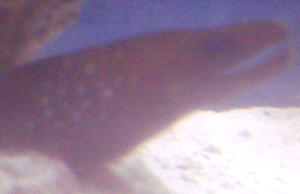 |
|
Re Unknown eel incompatibility; now sys. --
03/27/10
Hey so I'm looking for a bigger tank know, I'm hoping
that will help my eel problem. I found a 125 gallon tank but the
dimensions are 50 inches long and 60 inches high and 20 wide.
<Won't probably solve the problem of keeping the two
together, but should be sufficient for one of your eels.>
I also found one that is longer and not as high and it is also
125 gallons. I want to add a sting ray and a banded shark. Is
this a big enough tank?
<Certainly not for a ray and a shark. For the latter two
you'd want to consider about 3 times the size or more. Please
see http://www.wetwebmedia.com/sharks.htm
and http://www.wetwebmedia.com/rays.htm
. Also, their compatibility with moray eels is often rather poor
in the long run.>
If not what size is the right one, I get confused with the right
dimensions, should it be longer and not so high?
<Yes.>
Please help, and also what's a good filter can I use my
filter for my 46 gallon and buy another filter to add to this
one?
<I'd prefer a live rock filtered setup with a large
skimmer and strong water movement. Please see here for marine
filtration and setups: http://www.wetwebmedia.com/marine/setup/marsetupindex1.htm
Marco>
|
Unknown eel incompatibility --
03/28/10
I sent you a clearer picture of my eel? Will he be a
problem towards other fish as well, is he a violent vicious
eel? Thanks
<Yes, looks like a young Gymnothorax johnsoni aka
Whitespotted moray, although the head reminds me also of an
undulated eel Gymnothorax undulatus, which has a different
body coloration. Certainly a rare find. This eel is
probably going be around 4 feet long when grown and likely
is a threat to other fishes. The large grouper (hopefully
this is not in a 46 gallon tank) might be compatible,
though, if growing fast enough and offered sufficient
space. Cheers, Marco.>
|
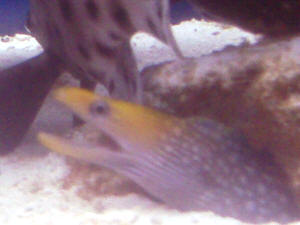 |
|
Moray Eel Identification 11/16/11
I occasionally get a species of moray eel from Sri Lanka
that I have yet been able to identify. I have attached a
picture. If you know what it is I would certainly
appreciate your answer.
Thank you, Aaron Dragseth - Aqua Life Aquarium
<Mmm, I think this may be Gymnothorax fimbriatus, but am
going to put your msg. in MarcoL's hands for a look/see
as well. Bob Fenner>
Re: Moray Eel Identification 11/16/11
Thank you for getting back to me so quickly, I'm really
interested in seeing what Marco and Bob have to say.
I'm pretty sure that it's not a fimbriatus though.
Gymnothorax fimbriatus has a tan body with black
blotches and this species has a darker body with white
spots. I do agree that the head and body style do resemble
a fimbriatus but unless it's a very different color
morph, I think it's a different species. Regards,
Aaron Dragseth
<+1. Marco.>
Moray Eel Identification 11/16/11
I occasionally get a species of moray eel from Sri Lanka
that I have yet been able to identify. I have attached a
picture. If you know what it is I would certainly
appreciate your answer.
Thank you, Aaron Dragseth - Aqua Life Aquarium
<Hi Aaron, we've had this species here on WWM in the
past... see http://www.wetwebmedia.com/MorayIDF5.htm
(scroll 2/3 down). I ID'd them as G. johnsoni
last year and it has occurred in trade since (I only get
bloody, sorry I mean blurry pics, no specimen), but with
your picture I have to correct myself. Both likely are
Enchelycore nycturanus. Your pic shows how slender
the jaw really is. This species was described 2002:
http://www.mapress.com/zootaxa/2002f/zt00104.pdf
. If you want to be sure look at the teeth, they are
different in G. johnsoni and E. nycturanus as noted in the
linked paper. Maximum size unknown so far. Cheers,
Marco.>
Re: re: Moray Eel Identification 11/16/11
Thanks Marco! That's a big help. I'm going to take
a closer look at the eels mouth tomorrow to see if I can
get a definite ID. I will let you know what I come up
with.
<Okay. Looking forward to it. Marco.>
|
|
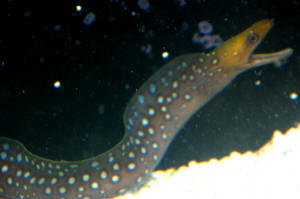 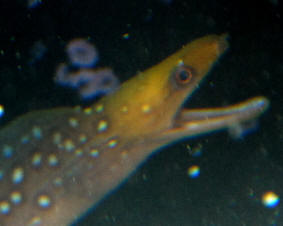
|
|
|
Eel ID -- 02/26/10
Hi crew of WWM,
<Hello Linda.>
I'm looking for help to ID my eel. Eel is approx. 30"
and has VERY sharp teeth (I know this first hand..Ummm, well,
Finger).
<Sorry to hear'¦ this is the most vicious eel
species I know.>
I sort of think he looks like a Brazilian Dragon Eel but what is
throwing me is the color. His spots are white and not yellow that
I see in most all the photos I see of them.
<You are right with your ID. This is Muraena pavonina, often
called Brazilian dragon eel a name that in the past was applied
to other Muraena spp. at least in trade.>
I'm attaching photos as well as the photobucket
links...I'm not sure which kind work better for you to
view.
<Both work. Thanks.>
Thanks in advance for your time and assistance with ID'ing
Eel.
<This species can undergo dramatic changes in color. Muraena
pavonina typically has very large white spots. That's how
they look mostly in nature and that's how they look freshly
after import. They most often change this pattern to the pattern
your eel shows within 6 months to 1 year. These smaller spots can
be white or slightly yellow, also dependent of the lighting of
the tank (/the camera/flash in the case of photographs). This
happens regardless of the size (I've imported pencil sized
ones and 2 feet specimens). The reasons are environmental, I
believe it's an adaptation, but I cannot tell you yet if the
critical parameters are physical, chemical or biological.>
Sincerely, Linda Close
<Kind regards, Marco.>
http://s112.photobucket.com/albums/n199/lclose5/Fish/?action=view¤t=P2220062-1.jpg
http://s112.photobucket.com/albums/n199/lclose5/Fish/?action=view¤t=P2220085-1-1.jpg
|
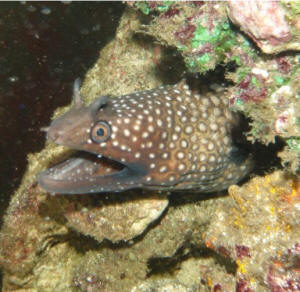 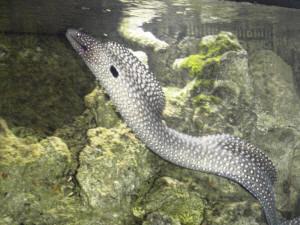 |
|
Re: Eel ID
Muraena pavonina; comp. -- 03/01/10
Eel lived with me for a few years and then I gave him to a friend
who took one of my 180 tanks. She is now breaking down her tank
and I am taking back Eel. I'm wanting to consolidate my tanks
here and need to decided on who to keep and who to give away to
other good/qualified fish keepers. I will have Eel in my 180 and
have to choose a few tank mates for him.
Choices are: a good size/fat/healthy PBT 4-5"
an equally sized Sailfin 5"
smaller size Scopas 3"
smaller size Kole 3"
decent size YT 4-5"
rabbit fish 3-4".
<All about equally endangered or compatible with regard to the
eel.>
All sorts of Inverts also: long black spin urchins, sea
cucumbers, various snails and shrimp
<Shrimps may get eaten.>
I absolutely can commit to frequent water changes, especially
with the idea of downsizing the number of tanks, so bioload
shouldn't be an issue but compatibility and keeping a humane
tank is my priority.
Can you give me some advice on who I should choose to be tank
mates with Eel? Eel seems to be very cautious when eating. In
Eels present tank when he smells food and accidentally finds a
tank mate he just mouths them and backs off (at least for the
past few years). He doesn't seem (at this point) to ever go
after anybody to eat them or to harm them, but then again he is
well fed.
<This depends a lot on the specimen. One certainly would not
be able to keep my largest M. pavonina with medium sized tangs or
rabbit fish in the long run, but if your moray accepted tank
mates so far, it might be possible. However, it may also fail
with time, since this species can get quite aggressive. Ensure to
add anything you want to keep with the eel first and give them
some time to get used to the tank.>
Thank you in advance for your input. Linda
<Welcome. Marco.>
|
|
Zebra eel? Of a sort, yes 1/23/10
Good morning (here anyway)! I have an identification problem. A
while back I acquired a beautiful eel sold to me as a juvenile
Zebra. I posted the attach pictures on my local forum and some
experienced hobbyists seem
to think it may not be a Zebra but a Snowflake Eel.
<Mmm, no; but a congener... i.e., of the same genus>
From my research, the main difference I notice is that my eel has
solid bands, unlike the scattered splotchy pattern seen most
Snowflakes seem to have. Could you help me identify it? It is
around 12-14" long and it is worth mentioning that the bands
are not exactly white in color, but yellowish. Attached are a
couple of pictures.
Thank you much!
Aly
<This looks to be a very nice specimen of Echidna polyzona.
Bob Fenner>
|
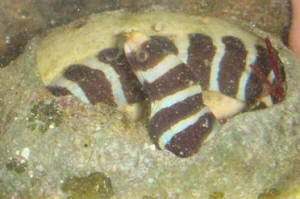 |
|
Echidna polyzona, ID, sys. -- 01/07/10
This is the eel I have purchased will you be able to identify
it?
<No, the picture shows too little, but the black bars I can
see seem to have a large distance for E. polyzona. You can count
the bars: E. polyzona has 24-30; G. rueppellii has less than
25.>
Also the ich problem I have my frogfish showed up dead and
I'm guessing it's from the ich along with one black
damsel.. the rest of the fish seem to be recovering.. I've
been adding the garlic and it stopped getting worse the minute
I've added it.
<I'd bet it cycled out.>
My panther grouper I don't think is eating as much as he
should be, he seems to stalk the frozen Mysis shrimp and grabs a
few but lets most just float by, also sometimes he will snatch a
piece of krill from the lionfish.. everything else is normal such
as swimming and behavior.
<Check the water parameters (especially nitrates and pH and
nitrates). PH should be between 8.0 and 8.4 and the nitrates
<25 ppm. Also, if you feed mostly Mysis shrimp and krill, you
should add vitamins, especially B1 (and others).>
I have one more question, I wanted to add a better light it's
a predator tank with no corals so I bought a 48" hanging
fixture from home depot that holds two 48" bulbs... the
people at the fish store told me I could put one actinic and one
10k bulb to give off, is this correct information?
<You can do that. You can also add two 10k bulbs. Depends on
if you like the actinic look or not.>
and also if it is would I be able to add some polyps and
mushrooms that only need
low light or would I be able to add more?
<It also depends on the water parameters. You might also be
able to add some easy soft corals such as Kenya trees.>
Thank you for the help.
<Welcome. Marco.>
|
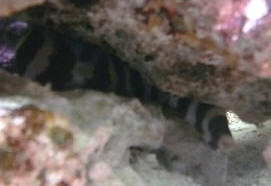 |
|
Echidna polyzona or Gymnothorax rueppellii?, ID, sys.
-- 01/17/10
I cant get a better picture of the eel, he hides all day and just
sticks his head out during feeding time only coming out a couple
inches, he does swim around at night. but the minute you turn the
light on to take a picture he hurries back to his hole and his
colors are faded anyway.
<Count the bands as noted in the previous mail. This should be
possible with a red light (e.g. weak torch with red
foil).>
He is really starting to look like a more predatory eel, such as
elongated face instead of the blunt roundness of most crustacean
eaters. also he's gotten big pretty quick I'd say about
doubled in girth and added 1-2 inches in the small time I've
had him.
<Sounds more and more like Gymnothorax rueppellii. This eel
would reach almost 3 feet and is very predatory.>
With the ich is almost all gone just on the two damsels and its
subsiding on them also.
<Don't add fish until you have not seen a single spot for
at least 4-6 weeks.>
The grouper also has started eating a lot again. I figure it was
maybe just a pause between growth spurts, also the Mysis shrimp I
feed are vitamin enhanced.
<Good.>
I added the light I mentioned earlier with the 48" 10k and
420 actinic (2) different bulbs. I am going to start some soft
coral soon and just wanted to make sure my inhabitants are reef
safe. I have the lionfish, grouper, maroon clown, two damsels,
and plan on adding the dragon wrasse and maybe a pink tailed
trigger- the reef safe one, and maybe a potters angel?
<If your Eel really is G. rueppellii the stocking list should
be changed or the eel removed. The Damsels, the Wrasse, the
Clown, the Angel might become food with time. Even the larger
species could be hurt. The Dragon wrasse is not always reef safe
anyway, when grown might likely eat snails, hermits, echinoderms.
When still small it might become food itself. The Angel may also
be eaten by Lionfish, Grouper or Eel at some point in the
future.>
I have a couple large Mexican turbo snails, two large hermit
crabs probably 4" shells
<Determine species. Some are not reef safe.>
, the eel, and a red sea urchin I'm not sure if he's reef
safe?
<This is a common name for Strongylocentrotus
franciscanus'¦ If this is your species, it is an algae
eater as long as it finds enough food.>
again thanks for all the help, you guys are great, also any
recommendations for types of soft coral?
<Depends on if you can keep the water parameters in line with
all these fish you plan to have. I doubt you would have good
coral growth. If you wish to try soft corals try some hardy Kenya
trees and maybe some blue or brown mushrooms. Cheers,
Marco.>
|
Viper moray question --
07/15/09
Hello (Marco, I assume?),
<How did you know? Hi Pat.>
I am currently looking at an animal labeled as a Viper Moray...the
size, description, and attached photo seem indicative of E. nigricans,
but I'd like to get your opinion as I have no desire to take on an
Enchelynassa canina.
<It is an Enchelycore for sure, no Enchelynassa. Very likely E.
nigricans'¦ or a Pacific species (isn't the ocean where
the animal comes from known to the current keeper?)'¦ like
E. bayeri, hard to tell from the picture.>
As to the former in captivity, do you have any experience?
<Yes'¦ similar to other larger Enchelycore
species.>
Please note that this picture was not taken by me and I am not
representing it as my own....I don't know if that dictates whether
or not you are able to post it.
<Nor do I.>
In case you recall, the E. lichenosa is doing fantastic...
<Great to hear.>
I'm in the middle of planning a tank upgrade as we speak and hoping
against hope that I'm able to find a E. anatina some time after
that.
<You know these two cannot be kept together? The E. anatina will
need colder temperatures. You'd likely have to catch one yourself
or know someone from the Northern subtropical Atlantic (esp. Canary
Islands) to help you out.>
Thanks, Pat
<Welcome. Marco.>
Viper moray pic
Sorry, forgot the pic in the last email.
<Got it. Thanks. But since we cannot post it, I'll delete it.
Marco.>
Re: Viper moray question, ID, sys. II -
07/15/09
Hi Marco,
<Hello Pat.>
Thanks as always...the person I'm thinking of buying this guy from
will likely not know where it came from...I'm assuming that
depending on locality it is either bayeri or nigricans?
< A good picture of the head showing details of the nostrils, pores
and teeth would help, but so far E. nigricans seems more
likely.>
Oddly enough, he did in fact have a fangtooth (first I have heard of in
the US) in the same tank as the 'viper'.
<Excuse my doubts. Was it really E. anatina? Picture?>
I understand that they enjoy some level of popularity in European
aquariums and have read several accounts of them being successfully
kept at 72-75F.
<I must have missed something here. Those very few aquariums I am
aware of all have them at colder temperatures.>
My understanding is also that they range about half way down the
western coast of Africa, and when they do come in, this is where they
are collected (along with a couple Muraena species that I see from time
to time).
<Ascension, Cape Verde and St. Helena are the most
'tropical' places, where E. anatina can be found, but the water
is colder over there than in American waters of same latitude. I am not
aware of occurrences of this species in the tropical parts of the
Eastern Atlantic a little North of the equator with typical marine tank
temperatures. The guide on Eastern Atlantic Muraenidae by
Böhlke seems to confirm this.>
Is this all hogwash?
<If there is any good proof I'd enjoy to stand
corrected.>
Because the animal comes first, as a back up I was thinking of
converting my current tank (150 'cube') to coldwater for the
anatina as well as an E. ramosa (at five feet max length I don't
know if the 3x3x3 would do it in the long run, though).
Thanks as always for your input Marco!
-Pat C.
<Anytime. Cheers. Marco.>
Re: Viper moray question -
07/16/09
Hi Marco,
<Hello Pat.>
If you'd like I can try to locate some of the material I've
gone through regarding E. anatina;
<Ah, very good. Thanks.>
I've included some of the easier to find links below. The maps
appear to indicate that they are found in warm water regions along the
west coast of Africa, and one source indicates that they are found in
the Bahamas, albeit as a deep water species...
<There is an old report (1880) of one at the Bermudas, maybe you
mean that one. About the links below: the first link shows very few
locations to me, none in tropical waters. The second link shows only
the rough areas'¦ click on the species name and you'll
come to Fishbase where the more accurate locations are named:
you'll see they are the ones I included in earlier mails. Also
click at occurrences to get a few more definite and even more accurate
locations.>
I can't find that article but the second link seems to back that
up.
As I said, the animal comes first and foremost, and I've been
interested in setting up a coldwater system for some time, so perhaps
this is a good excuse...it appears as though the Canaries maintain in
the mid 60s F...is that correct?
<I'd aim for 16-20°C (61-68°F) with an
exceptional maximum of 24°C (75°F) in
summer.>
Do you think that E. ramosa and E. anatina could make good tank
mates?
<Possible, may work best in a large system. Given how rare both
appear in trade, maybe this would be the first try.>
Without abusing my question asking privileges, do you have experience
with any other Enchelycore species?
<Taxonomy: yes; Aquarium care: limited, mostly second hand
information from public aquariums and a few keepers visited. E.
carychoa needs to be added to the ones discussed so far from my side.
That's one I could think about having at home myself.>
Map: http://www.discoverlife.org/mp/20m?kind=Enchelycore+anatina
FAO:
http://www.fishbase.gr/Country/FaoAreaList.php?ID=8087&GenusName=Enchelycore&SpeciesName=anatina&fc=56&StockCode=8397
I'm working on getting more pictures, hopefully a few clear ones of
both the 'viper' and 'fangtooth', I will pass the
latter on to you for your input.
<Great!>
I'm well aware that when it pertains to the exotic animals in this,
or any fauna hobby, people can get selective in their research and
ignoring sound advice against certain animals...you must run into that
quite a bit...please note I am not one of these and I do want to
provide, and am capable of delivering an adequate environment for these
creatures.
<From time to time people in Europe have brought home small Muraena
helena (a species that occurs in much of the range of E. anatina) and
had quite bad results in tropical tanks. It is good you are willing to
do better and can provide a cooler tank.>
Thanks! Pat.
<Cheers. Marco.>
|
Eel Help Please!; ID -- 07/13/09
My name is Terry and I'm from Deland FL. I think you have one
of the best web sites for CORRECT information!!
<Thanks!>
A few nights ago I lost my 3.5-4 ft zebra eel due to old age. I
was in a LFS today and I came a cross this eel. The store owner
really didn't know what type of eel this is or anything about
him/her. My wife liked the colors of it and talked me into buying
it. Can you please identify what species of moray this it?
<Gymnothorax eurostus also known by the common names Stout
moray, Salt'n Pepper moray, Abbott's moray and a few
more'¦>
He is about 13-16 inches and very active. I think it is a golden
tail moray, but I'm not sure.
<No, definitely not.>
Any information would be extremely appreciated.
<A fish and crustacean eater par excellence, will reach 2
feet.>
I have him in a 100 gal with a refugium, Coralife uv, Coralife
supper skimmer, two 1200 wave makers, two 1300 wave makers,
80-100 lbs of live rocks. My levels are zero except my nitrates
20-40, ph 8.2-8.3, salt 1.025 and temp 82. I have a 3.5 clown
trigger and a 3.5 undulated trigger.
<I do hope they work well together, I would not vouch for any
of your fish to leave the other two in one piece in the long
run.>
Thank you for taken the time to read my e-mail.
<Anytime. Take care. Marco.>
|
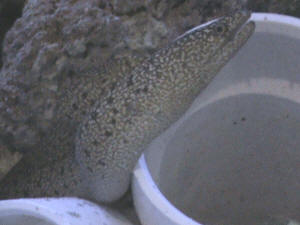
.JPG) |
Re: Eel Help Please! 07/14/09
Thank you once again for all your help and advice. The
Gymnothorax eurostus eel does not need any special care other
than the proper diet and a good environment?
<No, basically that's it with a good environment
consisting of many things like good water quality, many caves, no
moray eating tankmates, but also an escape-proof setup. See here
and in the linked FAQs above:
http://www.wetwebmedia.com/morays.htm .>
Thanks again Terry
<Welcome. Marco.>
Re: Eel Help Please!; G. eurostus --
07/15/09
Thank you once again for your good advice and also the great
link!
<Welcome.>
You said eel eating tank mates, you mean triggerfish?
<Some develop the bad habit to bite moray eel fins.>
I'm trying to get my eel on a feeding schedule but he/she
seems to want to eat all the time. I feed my two triggers once in
the morning and once at night time (small portions) and the eel
goes crazy in search for food. Should I be careful on how often
he eats?
<Yes.>
My zebra ate every other day (a couple shrimp or cam strips, or
krill). I have read that you should feed twice a week as much as
they want to eat. Is that the same for juveniles?
<Not as much as they want to eat'¦ they'll grow
too fast and become too fat. A healthy diet does not include
eating until you are absolutely full. In nature by far not every
hunt is successful, which is also proved by moray eel stomachs
being empty most of the time. I'd feed every other day
pieces, which together are as large as the entire head of the
eel.>
My new eel acts completely opposite from my zebra, he/she is out
all day and night, he swims around my tank, while my zebra just
came out late at night and stuck him head out of his cave, really
never swam around the tank other than feeding time.
<May change when settled in in a few weeks.>
Thank you again and sorry for all the question,
<No need to be sorry.>
I just want to make sure I am giving my eel the best treatment
that I can. I went and purchased some vite chem. vitamin drops,
is there any other you would recommend?
<Some far I had no problems with other brands made for
aquarium use. Just compare the ingredients if you feel
unsure.>
I also went and purchased pro salt silversides, clam strips,
squid and krill.
<Sounds good. Keep the diet varied.>
Thank you again. Terry
<Cheers. Marco.>
|
Eel aggression and ID -- 07/29/09
My name is Terry and I'm from FL, I have wrote to you
in the past and you have provided great advice.
<Thanks Terry.>
I am a great fan of your web site and I must say you
provide the best accurate advice. I purchased a 12-16 inch
moray eel about a month ago (Gymnothorax pictus, I think
that is what it is).
<As noted in the last email it is a Gymnothorax eurostus
(Stout moray, Salt'n Pepper Moray, Abbott's moray).
Beware, the G. pictus is also called Pepper moray, but is a
different species. Your eel definitely is a Gymnothorax
eurostus, head shape, eye size and location, what can be
seen of dentition and coloration (several color morphs are
known of this species) are indicative.>
I have it in a 100 gal with a 4" clown trigger and a
4" undulated trigger. It seems to be doing very well,
it is always out day and night. It is always swimming
though the tank. My question is, when I feed my two
triggers my eel gets extremely aggressive, I mean it takes
the food out of the triggers mouth, attacks them and just
gets really nasty, is that normal?
<Somewhat: yes. Could easily be the other way round. As
noted in earlier correspondence: I would not vouch for any
of your fish to leave the other two in peace in the long
run. Your eel is a fish and crustacean eater, and in
addition your triggers are not the peaceful side of the
spectrum.>
Last night I feed my clown a piece of clam strippers and my
eel swam out of a cave and crabbed my clowns head and tried
to swallow it. It let go and my fish seems to be fine (
still eating and not acting strangers, no marks) but is
that a sign that I need to feed more? I'm feeding like
every other day and sometimes every other couple days. Any
advice would be once again highly appreciated.
<You would likely reduce its activities when feeding
much more, but feeding too much for longer times will not
be healthy for your eel. Too fast growth and fatty liver
disease are among common reasons for moray eels dying in
captivity.>
Thank you, Terry.
<Your options are basically: see if the unwanted
behavior changes with time when feeding a little more or
separating them. Cheers, Marco.>
|
 |
|
|
|

